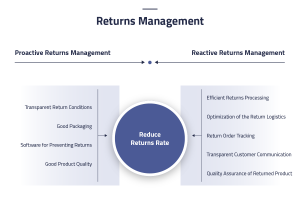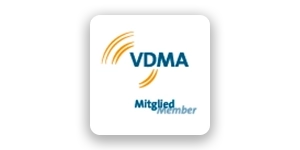E-Commerce
Returns Management in E-Commerce

Content
Why is Returns Management Important?
A professional and transparent returns management is of utmost significance for sales in e-commerce when it comes to fulfilling the customer’s expectations and reducing costs. A well-organized returns management enables customers to send back their products without any problems which, in turn, translates into positive feedback and an overall higher customer satisfaction. Additionally, an efficient returns management allows for the refurbishment and reuse of products, which hereby reduces waste output and is easy on the environment. Good returns management can even be proactive and guarantees that the number of returns is lowered. Bad returns management, to the contrary, can lead to considerable financial losses since unclear processes and high return costs limit your company’s profitability. In order to secure your long-term success, then, it’s indispensable to invest into an effective returns management.
The Two Approaches to Returns Management
In returns management, there are two kinds of approaches. Both are to be optimized: On the one hand, the proactive or preventative returns management which is about taking measure to minimize returns before they have a chance to come up in the first place. With it, you can reduce return rates. On the other hand, there’s reactive returns management. This is about completing returns in the best possible manner to minimize the costs of processing them. On top of that, you’ll need to make a decision on what you want to do with products returned in such a manner.
Proactive Returns Management
Simple and transparent return conditions are decisive when it comes to making it easy for your customers to understand when and when not products can be returned and how this return is processed. Clear communication and a simple reverse transaction process contributes to smooth returns and a positive customer experience.
The good packaging of the goods is crucial for keeping the return rate at the minimum. Appropriate and secure packaging protects the product from damages which may occur during the return shipping and, consequently, minimizes the risk of transport damages. Additionally, an appealing packaging for the goods can also contribute positively to customer experience and the overall quality of the product. A meticulous and high-value packaging can increase customer satisfaction, minimize the number of returns, and also boost your company’s image.
The use of software for preventing returns in advance allows you to automate related processes and identify risks revolving around returns. Spotting potential returns ahead of time enables e-commerce companies to react immediately and take appropriate measures for avoiding it. This, then contributes to an effective return procedure and cost savings.
Good product quality is highly relevant for achieving a low return quota. Here, one possibility is to improve the product description or product images in order to provide more detailed information and a more realistic representation of your products.
On top of that, a size chart or a perfect fit guide, for example, can support your customers in finding just the right size that fits their individual body proportions and figure. This assures that customers make an informed purchasing decision and minimizes the probability of a product return because of issues related to size. In this context, an efficient variant management can also be of great help to your customers.
The general rule of thumb is: When a product boasts with high quality and matches the customer’s requirements, there is a lower probability that it will be returned. Good product quality helps avoiding any mispurchase and dissatisfied customers since customers will feel that the acquired product perfectly fits their expectations. By focusing on high product quality, companies can regulate the number of returns, enhance customer retention, and, ultimately, also improve the overall profitability.
Reactive Returns Management
Quick and efficient returns processing is the deciding factor for minimizing the length of the overall procedure and for avoiding frustration on the customer’s side. Thanks to fast transactions, you can inform them about the current state of the return on the spot and, consequently, increase the satisfaction with the company’s service.
The optimization of the return logistics is important in order to reduce the costs for transport and storage. By designing their logistics processes in a more efficient manner, companies can minimize the return costs while also reducing the environmental pollution.
Return order tracking enables you to analyze the reasons for returns and find suitable counter measures for improvement. Through the identification of recurring problems, your online sales team can develop solutions that will avoid returns of goods in the future.
Transparent customer communication is necessary to keep everybody informed about the state of the return and corresponding compensations. An open manner of communication can strengthen the customers’ trust as well as their satisfaction.
The quality assurance of returned products serves the purpose of making clear decisions about reselling, repair, or further processing the product. Thorough testing guarantees that the returned product is safe for sale again or that it can be utilized for other use cases. If the goods are ready for resale, the question is how this is to be carried out – you may, for example, tap into secondary markets.
Pros and Cons of a Returns-Based Secondary Market
A returns-based secondary market comes with some benefits which support you in managing returns. Through the sales of returned products on a secondary market, the costs for disposal or reprocessing can be reduced. At the same time, it even offers you opportunities to generate additional income and, consequently, increase profitability. Furthermore, rebuys from customers contribute to environmental sustainability since the amount of waste involved is lowered and resources are preserved. Last but not least, customers are always happy to purchase these products at a cheaper price.
Despite these advantages, however, you’ll also have to keep some potential disadvantages in mind. Setting up and managing a secondary market can be time consuming and complex, therefore requiring additional personnel and effort. An additional source of danger is the so-called cannibalization effect, where the sales of returned products limits the sales of new products from the same assortment. Companies must be mindful that the secondary market doesn’t negatively affect the brand image or threatens customer trust. All in all, this requires a careful consideration of both pros and cons in order to get the optimum out of a return-based secondary market.
The question whether or not a secondary market is indeed meaningful for a company is to be decided on an individual basis.
How can a PIM System Support Your Returns Management?
A PIM System (Product Information Management) can lend important support to your effective returns management. By using a PIM system, companies can create and manage a central database for all product information. The system enables easy organization and updates of product attributes, specifications, images, and other relevant information. Through user-defined quality assurance mechanisms and automated workflows in PIM, you can guarantee that the product descriptions and images presented in your online shop are always up to date and provided in the right quality. This also contributes to the fact that customers won’t come to form wrong expectations and it also reduces your return quota.
Through the central management of product information, the PIM system also enables you to update return guidelines and conditions in a quick and easy manner so that the return process is fully transparent at all times. On top of that, a PIM system provides you with the option to analyze customer-related feedback and return messages so that you can implement product improvements and quality assurance. And it also offers the possibility to use the PIM as the data basis for your return-based secondary market.
An efficient PIM system can support companies in their profitable returns management, strengthen the customer retention, and positively impact business success in a sustainable manner.
Make Your Product Data Model the Next Top Model
With our checklist, you’re equipped with a practice-centered guideline for bringing your product data into top form in virtually no time.
From Our Blog
You may also be interested in the following articles








